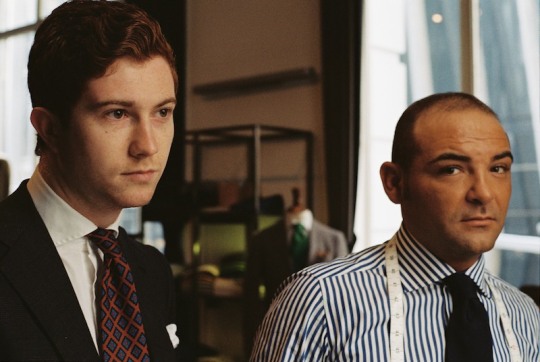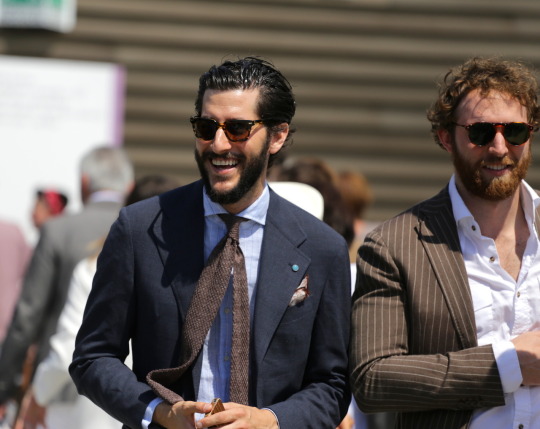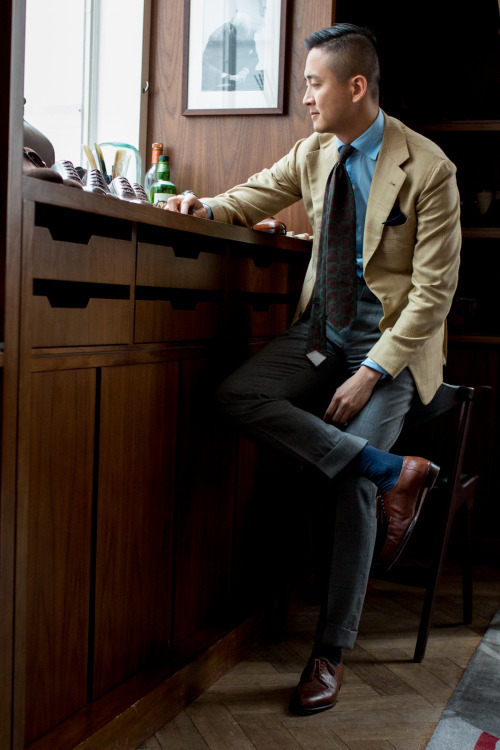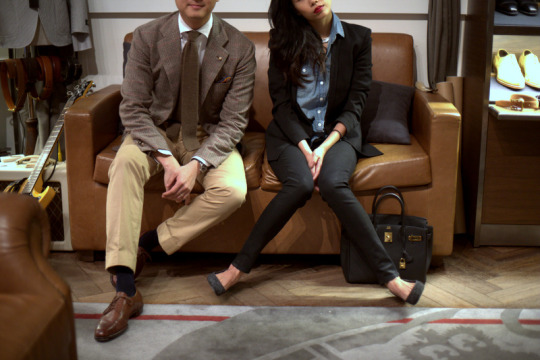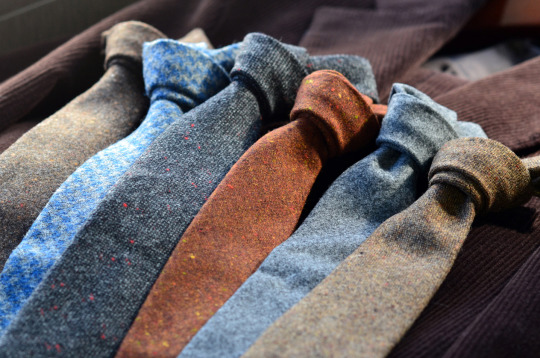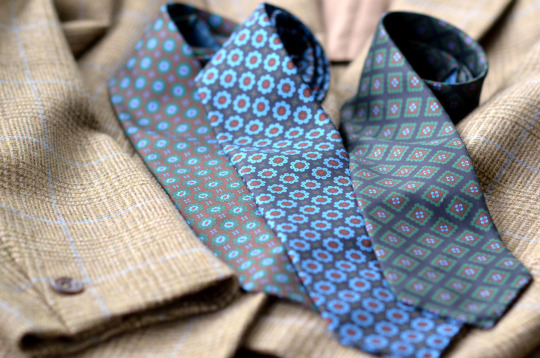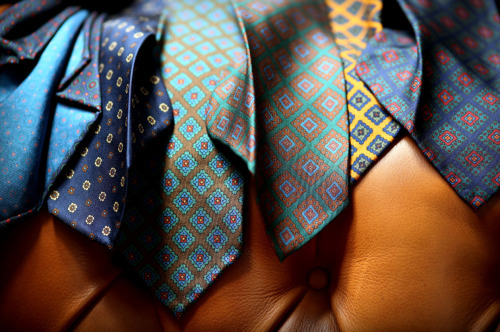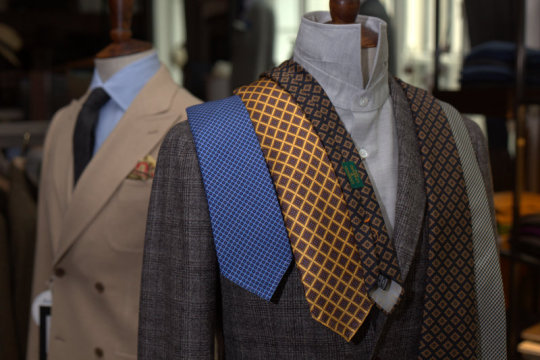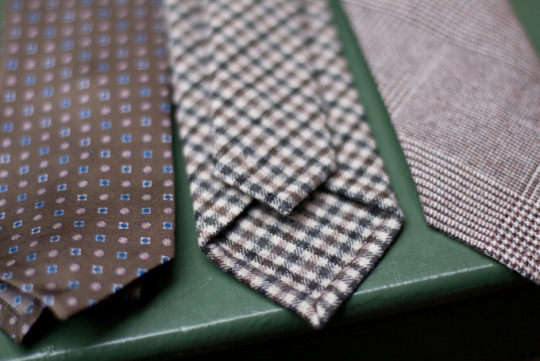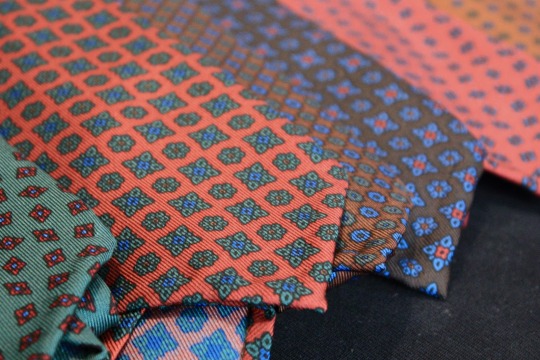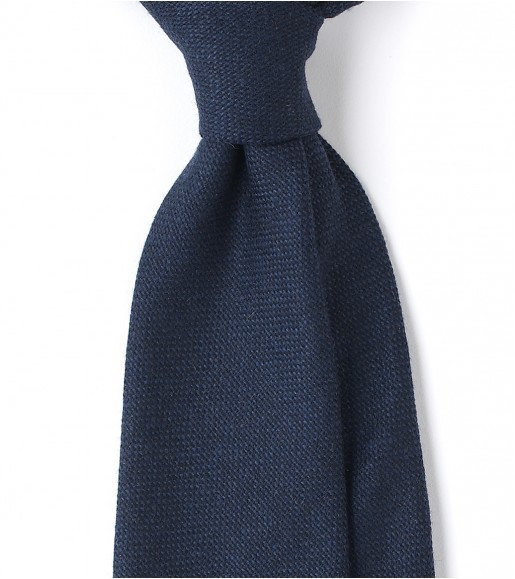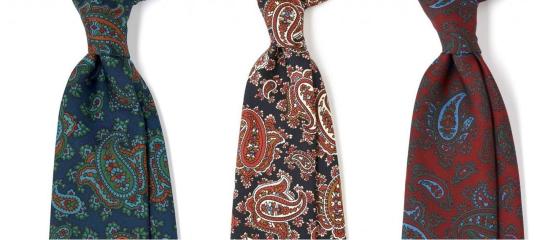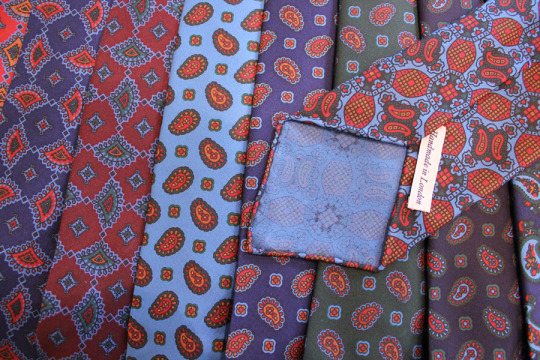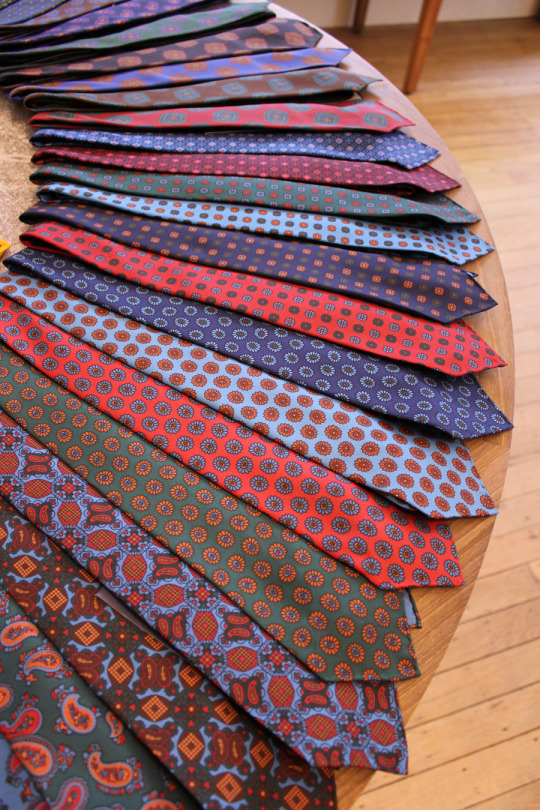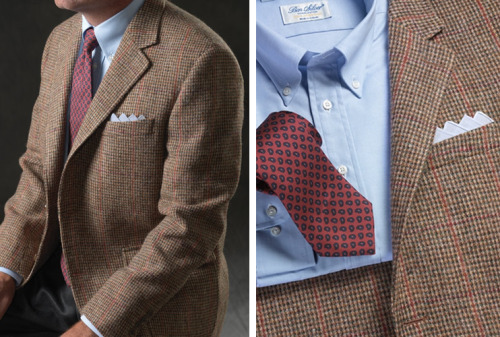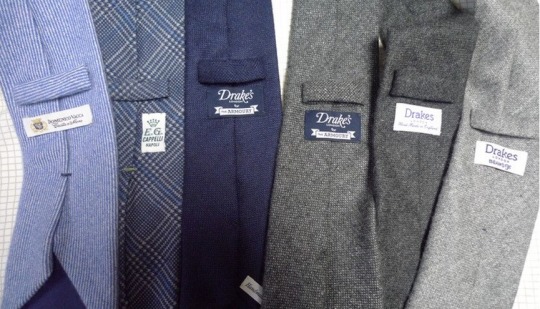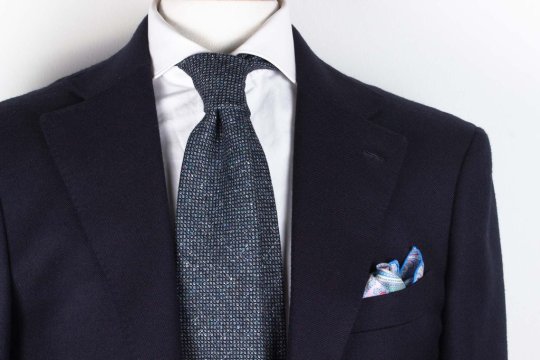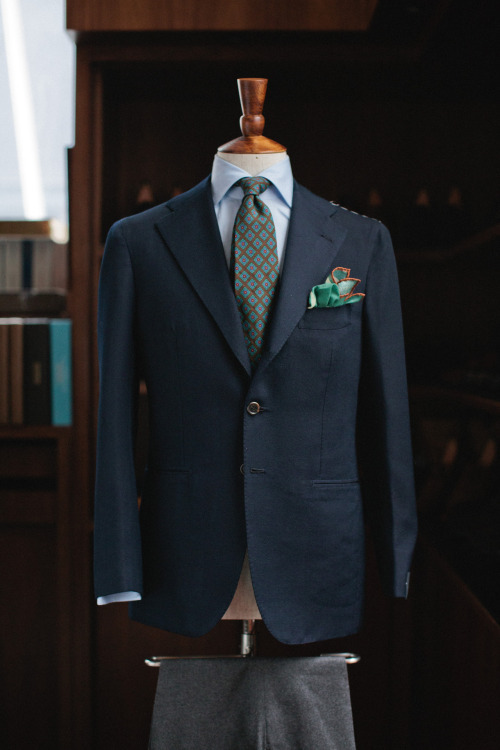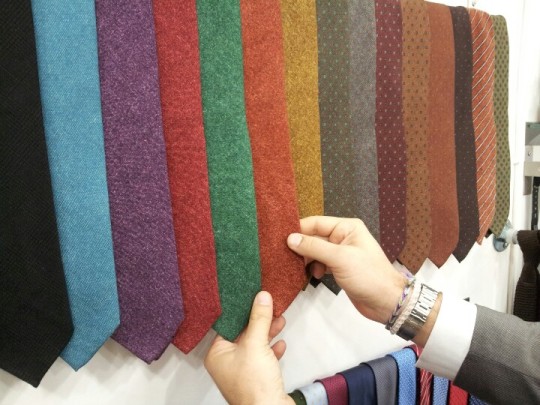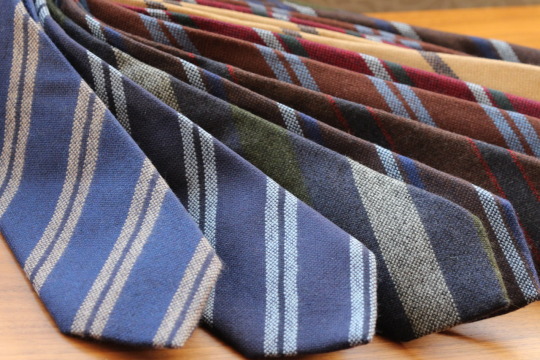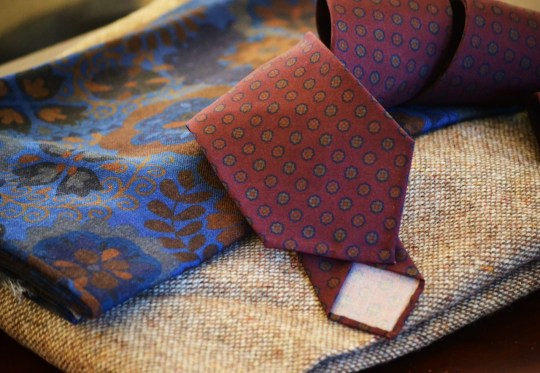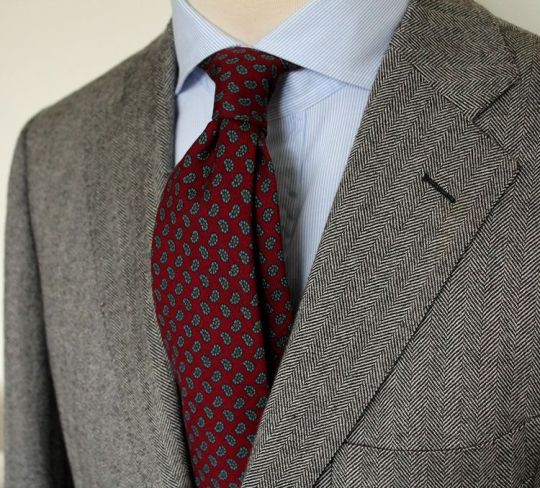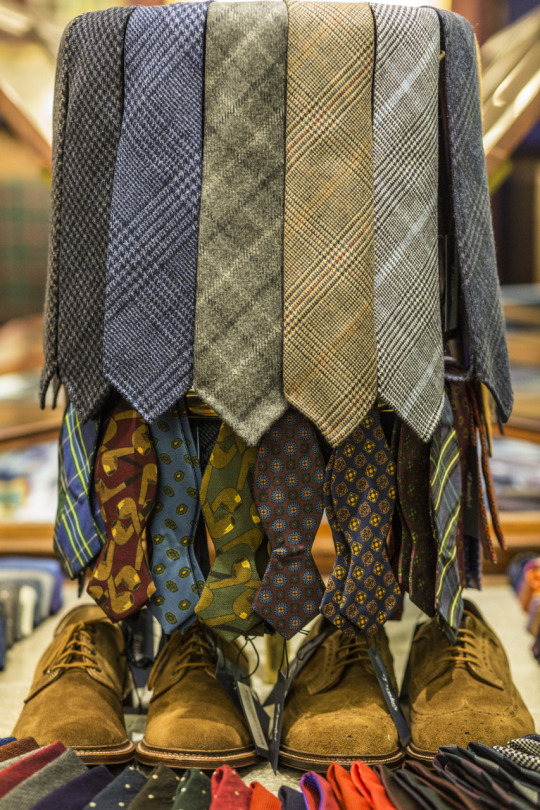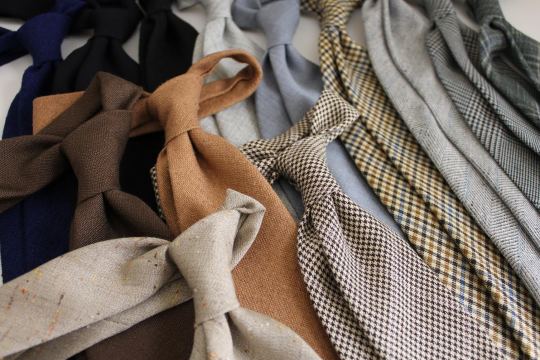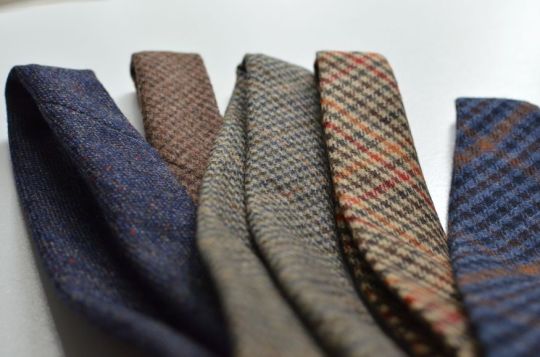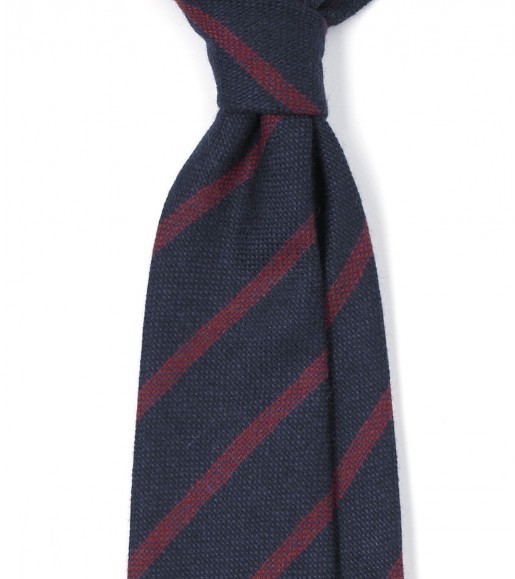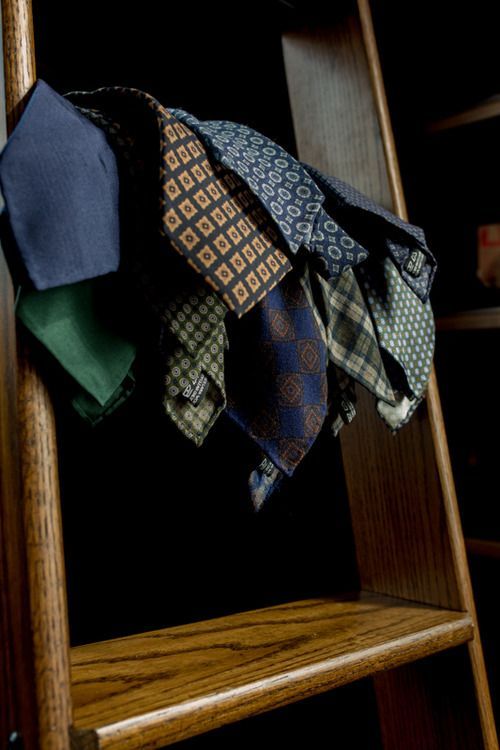
Fabrics are my favorite part of fall/ winter wardrobes. Heavy tweeds, corduroys, and flannels for tailored clothing. Then sturdy wools and leathers for casualwear, as well as spongy alpacas and Shetlands for knits. Everything just looks and feels so cozy.
The same goes for ties. Although few men need more than a handful of ties nowadays – some striped rep silks, solid-colored grenadines, and basic knits – seasonal neckwear is a great way to add joy to a wardrobe. Alan Cornett put it well recently when he said: “some purchases flavor a wardrobe, though their proportions are small.” A well-chosen tie, pocket square, or scarf is a great way to give a nod to a certain season or occasion, “changing the tenor of an ensemble.” A wool tie can complement the cold-weather feel of a tweed jacket, or add an autumnal touch to a navy worsted suit.
There are thousands of fall/ winter ties out there, but broadly speaking, you’re looking at five categories:
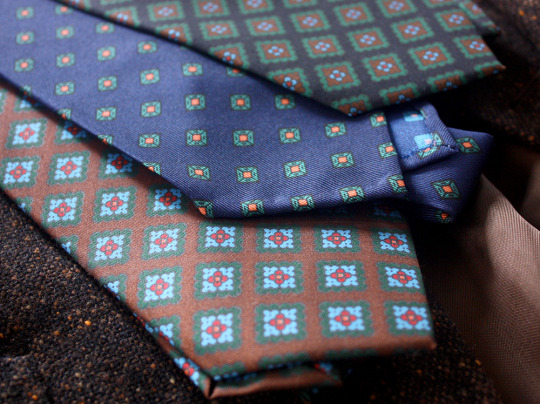
CHALKY ANCIENT MADDER
Paul Winston over at Winston Clothiers once told me that the suede-like feel of ancient madder reminds him of a horse’s nose. I’ve always thought that description was charming.
The term madder actually refers to two things. The first is the rich-red, vegetable dye that’s derived from the Eurasian plant Rubia tinctoria. In ancient times, it was used to dye regal clothes, which Bruce Boyer says is how we get the “ancient” part of ancient madder. Then we have “madder style,” which is an old method of printing that involves using thickened mordants, drying, aging, dunging, and dyeing with alizarin (the coloring agent obtained from madder root) or other coloring agents. I’ve never known whether madder in silks refers to the first or the second, but for what it’s worth, not all madder ties contain red.
At some point, scientists discovered that two of the three dyes used to make madder causes cancer in rats. Which meant, when printers dyed their silks and dumped the solutions out to disposal plants, they risked getting carcinogens into water supplies. They never found a way to filter out those chemicals, so the dyes were banned and replaced with synthetics. Today, only the third dye (indigo) remains in its original form.
Today’s madder silks still have that chalky hand, but they miss the muted look of yesterday’s prints. They’re brighter and more vivid, especially in areas where the silk has been dyed red. Still, they make for great fall/ winter neckwear. Just as good with tweed and corduroy sport coats as they are with worsted suits and pinstripes. Paisley patterns are traditional, but I particularly like them in diamond motifs, like you see above.

FUZZY WOOL, WOOL-BLENDS, AND CASHMERE
There’s as much variety in wool and cashmere neckties as there are tailored jackets – everything from flecked Donegals to fuzzy wools to soft cashmeres. Add to that any number of patterns and you can see how this category could be broken up into ten more.
I like wool and cashmere ties in darker colors (a light-grey one purchased years ago doesn’t get as much wear this charcoal) and lighter constructions. Since the material itself can be a bit thick, especially if it’s tweed, it’s important to make sure the interlining and padding inside are thin, and there aren’t many folds. Otherwise, even your tightest four-in-hand knot can look like a full-Windsor.
The upside to a solid-colored wool tie isn’t too unlike the advantage of silk grenadine. The simple color makes it easy to pair with a patterned jacket, while the texture adds visual interest to solid colored suit or sport coat. I also like them in patterns, such as district checks, although I find I reach for my solid-colored ties more. For the best of both worlds, consider unique weaves, such as birdseye, herringbone, or Donegal. Wool blends can also sometimes have more interesting textures than pure wool.
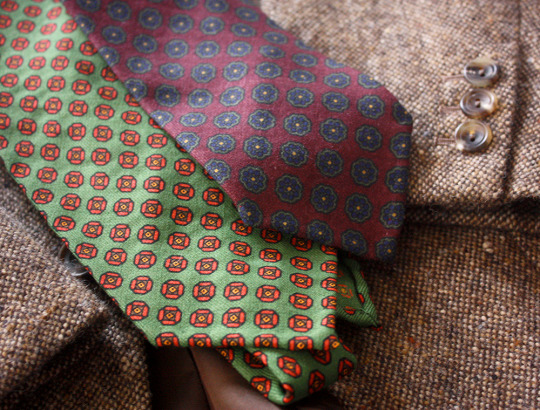
DRAPEY WOOL CHALLIS
A special enough category for wool ties to deserve its own mention. Wool challis has been used in men’s clothing since the 19th century, when it was first woven in Norwich, England. The term challis is actually a corruption of the imported Indian word “shallee,” meaning “soft.” And it’s that softness that makes wool challis so wonderful. Unlike many wool you’ll find elsewhere, wool challis has the softness you want out of a fall/ winter tie, but none of the bulk.
About fifty years ago, people still hand block printed on wool challis. That means large blocks of wood (roughly about the size of a piece of paper) were set with ink and then pressed against the fabric. The process was labor intensive, but the prints beautiful.
A former David Evans manager once told me, however, that customers used to complain about the small inconsistencies found in hand block printed ties (any handwork is bound to have some small variation). That, coupled with the need for great efficiency, means that almost all wool challis today is silk screened. The process is still done by hand, but here, a large screen is set against the wool and a rubber blade is then passed from one end to another. This pushes the ink through certain parts of the screen, which sets the pattern. Thankfully, the quality here is just as good as the old methods.
If I had to narrow my neckwear wardrobe, it’d probably come down to just a handful of ties in ancient madder and wool challis. The second is just easier to work with in the morning given its firmness and weight. It drapes beautifully and ties up nicely, giving you a substantial, but small knot. Imagine your favorite silk ties, but with a soft and supple hand, as well as a matte finish.
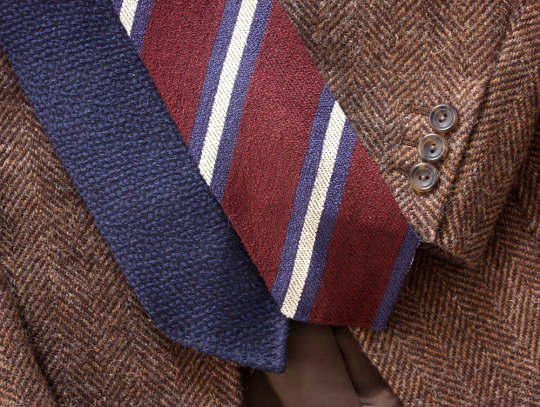
TEXTURED BOUCLE
You don’t see boucle used much in menswear, especially traditional tailoring. It’s more often than not reserved for women’s clothing, or the occasional adventurous menswear designer. Maison Margiela has used it in the past for knitwear; Lemaire for coats. The fabric is distinguished by its uneven surface – a nubby surface with tiny loops and knots twisting over on themselves, as though the yarns were made from thousands of badly tangled lengths of string.
The material makes for great neckties, however. Think of boucle as the winter version of raw silk – something with a rough, uneven surface for a casual look. Like with a raw silk tie, boucle neckwear is a nice way to dress down a suit or sport coat.
Unfortunately, they’re hard to find. Drake’s has some boucles this season in a grenadine weave, and you may be able to find some old-season striped designs on eBay. The Knottery also had a great one a few seasons back (it’s the navy one pictured above). A bit more adventurous, but fantastically textured and fun to wear.

FLOPPY WOOL KNIT
I’m a big fan of knit ties. They’re a little more floppy and casual than your traditional four-in-hands, and the perfect choice for guys who want to look a bit more dressed down in their neckwear.
Most knits are made from silk, but wool and cashmere are great if you want some variety. They’re softer and more matte, giving them a more cold-weather feel. I especially like them with Shetland tweeds, corduroy sport coats, and chunky hopsack jackets. For your first one, get black. It goes with everything. One little trick: if you get knits with pointed ends, rather than square, you’ll have a bit more wiggle room in terms of tying it at the right length. Getting a pointed end to hit your belt is a bit easier than getting a square one to do the same.
If you’re looking to shop for ties in any of the categories mentioned above, I’m a big fan of Drake’s, EG Cappelli, and Tie Your Tie. You can find them at a few of the sponsors on this site (e.g. No Man Walks Alone, A Suitable Wardrobe, and Exquisite Trimmings), as well as The Armoury and Mr. Porter. I also like the selection at certain trad clothiers, such as O’Connell’s and Ben Silver, as well as niche shops such as Panta, Shibumi, Vanda Fine Clothing, and Berg & Berg. The stuff at Bryceland’s also looks great (and refreshingly unique).
Additionally, if you order clothes from a bespoke tailor, you can probably get a good tie from them. Many have house lines, even if the ties themselves are made by other companies. I particularly like the selection at Anderson & Sheppard.
Lastly, Sam Hober is probably the best value (top-end bespoke for under $100 is hard to beat), and Antonio Muro is very underrated. I stumbled upon Muro years ago when I was in Naples, and their ties stood out in a crowd of fashion junk. For affordability, check Ralph Lauren when they’re having their sales, as well as Chipp.
(photos via Voxsartoria, The Armoury, Drakes, Eidos, Vanda Fine Clothing, EG Cappelli, Panta Clothing, Arnold Wong, Alan See, Ben Silver, and Marshall Anthony)
